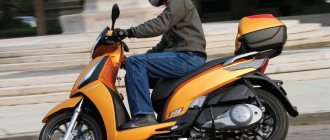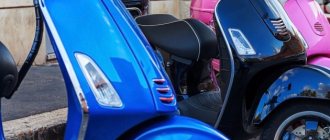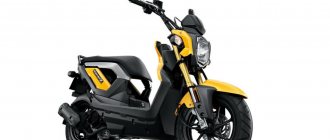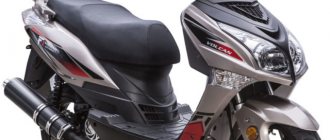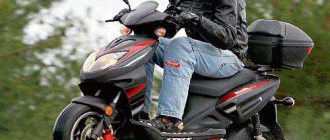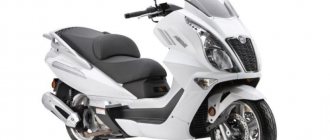Scooter engine - device Scooter carburetor - device, setup Scooter crankshaft Scooter gearbox - device Scooter clutch - device, setup Scooter variator - device Scooter chain drive device Scooter electrics Scooter brake system Switch - electronic ignition of the scooter Scooter speed limiters
Advantages of four-stroke engines
| Advantages of two-stroke engines
|
The design and principle of operation of a four-stroke engine and a two-stroke engine
The working cycle of a four-stroke engine consists of four main stages - strokes
. The piston is a metal cup surrounded by spring rings (piston rings) inserted into grooves on the piston. Piston rings prevent gases generated during fuel combustion from passing between the piston and the cylinder walls. The piston is equipped with a metal rod - a pin, connected to a connecting rod. The connecting rod transmits the linear reciprocating motion of the piston into the rotational motion of the crankshaft.
Read also
Diagnosis of scooter malfunctions
15. Diagnosis of scooter malfunctions Even such a simple and reliable mechanism as a scooter can break. The reason for this may be poor quality and untimely maintenance, bad gasoline, general fatigue of mechanisms, banal vibration, road dirt, etc.
Scooter repair
16. Scooter repair 16.1. Scooter repair. Facings - removal and installation Partial or complete removal of the facings is necessary for most scooter maintenance and repair operations. ATTENTION! The plastic of the scooter is fragile; when removing and installing it, you must
16.11. Scooter repair. Tires - replacement
16.11. Scooter repair. Tires - replacement REMOVAL 1. Remove the cap from the valve, press the spool to relieve pressure in the tire.2. We remove the wheel (see Front wheel - removal and installation or Rear wheel - removal and installation. 3. Set the tire beads from the landing
16.15. Scooter repair. Brake fluid - replacement
16.15. Scooter repair. Brake fluid - replacement CAUTION! Brake fluid is toxic, use caution when working with it. If it comes into contact with skin, wash it off with warm water and soap. WARNING: Use only the type of brake fluid recommended
16.16. Scooter repair. Brake disc - replacement
16.16. Scooter repair. Brake disc - replacement The brake disc must be replaced if it is severely worn (the minimum permissible thickness of the working area is indicated on the base of the disc), or if it is deformed, for example, after the scooter has been dropped. REMOVAL To remove the brake disc
16.19. Scooter repair. Headlight light - adjustment
16.19. Scooter repair. Headlight light - adjustment1. The direction of the luminous flux of the headlight is changed by turning the adjusting screw. Adjustment is necessary when the road lighting in front of the scooter is disrupted, when the headlight beam blinds the driver of oncoming traffic, but
16.25. Scooter repair. Rear shock absorber - replacement
16.25. Scooter repair. Rear shock absorber - replacement REMOVAL Place the scooter on the center stand.1. Unscrew the bolt of the lower shock absorber mounting.2. Remove the bolt from the lower shock absorber mounting.3. Unscrew the nut of the upper shock absorber mounting, when
16.27. Scooter repair. Muffler - removal and installation
16.27. Scooter repair. Muffler - removal and installation REMOVAL 1. Holding the fixing nuts with a spanner or socket wrench, use a hex wrench to unscrew the three bolts securing the muffler to the pipe.2. Using a hex wrench, unscrew the three bolts securing the muffler to the frame and
16.29. Scooter repair. Adjusting valve clearances
16.29. Scooter repair. Adjusting the valve clearances The rear facings have been removed, the saddle with seat reservoir has been removed, the cylinder head cover has been removed (see Facings - removal and installation).1. Valve clearances are adjusted on a cold engine.
16.31. Scooter repair. Generator - disassembly and inspection
16.31. Scooter repair. Generator - disassembly and inspection REMOVAL To get to the generator, it may be necessary to remove the side trim (see Facings - Removal and Installation)1. Unscrew the screws securing the plastic fan casing.2. Remove the cover
16.35. Scooter repair. Starter relay - replacement
16.35. Scooter repair. Starter Relay - Replacement REMOVAL To remove the starter relay, you must first remove the rear trim of the scooter (see Trims - Removal and Installation).1. Using a hex wrench, unscrew the bolt securing the starter relay.2. Remove from the starter relay
16.36. Scooter repair. Starter - removal and installation
16.36. Scooter repair. Starter - removal and installation REMOVAL To dismantle the electric starter parts, you must first dismantle the variator cover, remove the variator belt and drive pulley (see CVT - disassembling and assembling the drive pulley).1. Unscrew the two screws on the front
16.38. Scooter repair. Variator belt - replacement
16.38. Scooter repair. CVT Belt - Replacement REMOVAL (Shown on removed power unit)1. Place the scooter on the center stand.2. Using a hex wrench, unscrew the kickstarter bolt and remove it from the axle.3. Unscrew all the cover bolts
16.43. Scooter repair. Oil seals - replacement
16.43. Scooter repair. Oil seals - replacement Lip seals, or oil seals, are used to seal moving joints of mechanisms, to prevent oil from leaking out of the mechanism and from getting water, dirt and dust into it. The difference between an oil seal and a simple gasket
16.44. Scooter repair. Bearings - troubleshooting and replacement
16.44. Scooter repair. Bearings - troubleshooting and replacement All bearings are divided into two large groups: plain bearings and rolling bearings, which, in turn, are ball, roller, needle, radial, angular contact, conical, etc.
Compression - 4-stroke engine
The piston of a four-stroke engine rises from BDC to TDC, compressing the working fuel mixture. At the same time, the temperature of the combustible mixture rises significantly. The ratio of the working volume of the cylinder at BDC to the volume of the combustion chamber at TDC is called the compression ratio (not to be confused with compression). The compression ratio is a very important parameter; usually, the higher it is, the greater the fuel efficiency of the engine. But a four-stroke engine with a higher compression ratio requires fuel with a higher octane number, which is more expensive.
What are the most reliable scooters: what to look for
It is necessary to approach the choice of an “iron horse” with special responsibility. After all, by purchasing a low-quality product, you risk harming not only your health, but also the health of the people around you. In addition, riding a poorly assembled moped will not bring you proper pleasure.
- The motor is the first thing you need to pay attention to. After all, almost everything depends on the choice of the type of internal combustion engine: from the durability of the device to its behavior on the road in dense traffic.
- Power is also an important indicator, on which not only speed, but also the level of its maneuverability depends.
- Manufacturer. A brand is an indicator of the quality of parts and their assembly. Well-known bike brands closely monitor each assembled unit, so defects in their products are extremely rare. It often depends on the manufacturer whether you will use the equipment for a long time, or whether in a month you will put it in the garage or sell it for spare parts.
- Consumables and spare parts. High-quality and more expensive consumables and spare parts guarantee a long service life.
Combustion and expansion (piston stroke) - four-stroke engine
Shortly before the end of the compression stroke, the combustible mixture is ignited by a spark from the spark plug. As the piston moves from TDC to BDC, the fuel burns, and under the influence of the heat of the burned fuel, the working mixture expands, pushing the piston. The degree of “under-rotation” of the engine crankshaft to TDC when the mixture is ignited is called the ignition timing angle
. Ignition advance is necessary so that the gas pressure reaches its maximum value when the piston is at TDC. Then the use of energy from burned fuel will be maximum. The fuel combustion rate practically does not change, that is, it takes a fixed time, therefore, in order to achieve maximum engine performance, you need to increase the ignition timing in proportion to the crankshaft speed level. In older engines, this adjustment was made by a mechanical device (centrifugal and vacuum regulator acting on a breaker). More modern engines use electronic ignition timing to adjust the timing.
what scooter
Forum users, tell me which is better to take a scooter, 2-stroke or 4-stroke. Which company do you recommend?
Nissan Primera p10, automatic transmission sr20de. Flushing heaters without removing. Repairing internal combustion engine, chassis. 89831323992
It’s better to take a 2-stroke or 4-stroke scooter from some company.
Better than 4. I had 2 capital every year.....
Chevy Avalanche V8 5.3 Z71 chip 380 hp Cady Escalade V8 6.2 Platinum chip and exhaust 440 hp
Take a 2-stroke, I’ve driven Suzuki Sepia since I was young, it’s a reliable machine. But you should definitely take a Japanese one, you can even buy a used Yamaha for a fast ride, a Honda for an average ride but with a beautiful appearance. Honda - Dio 3rd generation Yamaha - Axis seems to be driving very well...
Personal trainer for bodybuilding and fitness.
Posted by
SpainerBetter than 4. I had 2 capital every year.....
The piston was changed, which means it’s already... I also had it while the Japanese one was standing for 2 years (I killed it for 14 years
 ). I broke it, installed it in China, since they don’t bring Japanese ones, I also made some capital during the run-in)))
). I broke it, installed it in China, since they don’t bring Japanese ones, I also made some capital during the run-in))) Personal trainer for bodybuilding and fitness.
Message from
T580RNTake a 2-stroke, I’ve driven Suzuki Sepia since I was young, it’s a reliable machine. But you should definitely take a Japanese one, you can even buy a used Yamaha for a fast ride, a Honda for an average ride but with a beautiful appearance. Honda - Dio 3rd generation Yamaha - Axis seems to be driving very well...
Yes, they all seem to be traveling no more than 50))
Message from
Sashka MajesticYes, they all seem to be traveling no more than 50))
60
Chevy Avalanche V8 5.3 Z71 chip 380 hp Cady Escalade V8 6.2 Platinum chip and exhaust 440 hp
take a Yamaha ubr125, a small motorcycle, the price new was about 70
Message from
Sashka Majestictake a Yamaha ubr125, a small motorcycle, the price new was about 70
https://www.panavto.nsk.ru/index.php?...odetail&id=895 but here you need rights. With this money you can find 400k. Although new is new. On topic, it’s better to buy a used Japanese one. What they sell in our feeds is complete slag, and for that kind of money. I watched it recently while taking it to a child. On Korolev, they sell spare parts for scooters from China. A piston with rings costs around 300 rubles at retail. I don’t even know what can be done with that money.
Honda CRV Suzuki Intruder 1500
Message from
Neenothttps://www.panavto.nsk.ru/index.php?...odetail&id=895 but here you need rights. With this money you can find 400k. Although new is new. On topic, it’s better to buy a used Japanese one. What they sell in our feeds is complete slag, and for that kind of money. I watched it recently while taking it to a child. On Korolev, they sell spare parts for scooters from China. A piston with rings costs around 300 rubles at retail. I don’t even know what can be done with that money.
the price was raised by 10))) at the beginning of April 69 was) you need a license, but they don’t check much for the driver’s license, mono and without them)
4-stroke and not Chinese! And their service life is very different, guess what! It might last a month, maybe 5 years!
I need to take a fashionable Votsik, soon it will be warm
Message from
CBuHIt’s better to take a 2-stroke or 4-stroke scooter from some company.
+1
Last edited by guba; 05/03/2010 at 20:17.
Used Subaru cars
take my Honda Dio, I don’t know what year, black, looks fresh, works great, I don’t know anything else. 20t.r.
Used Subaru cars
Used Subaru cars
Posted by
denn54Forum users, tell me which is better to take a scooter, 2-stroke or 4-stroke. Which company do you recommend?
For some reason I immediately remembered the joke: two women were talking, one said to the other and said that the husband in bed is like a moped =)) the second one asks, how is it like a moped?? o_O and the first one answers, two strokes of injection =))))
They sell scooters in the feed. 37 tr
https://novosibirsk.baza.drom.ru/rezina-letnjaja-r14-175-65-yokohama-35067104.html urgently
Current time: 02:44. Time zone GMT +3.
Issue - four-stroke engine
After BDC of the power stroke of a four-stroke engine , the exhaust valve opens and the rising piston forces the exhaust gases out of the engine cylinder. When the piston reaches TDC, the exhaust valve closes and the four-stroke cycle begins all over again.
It must also be remembered that the next process (for example, admission) does not necessarily have to begin at the moment when the previous one (for example, exhaust) ends. This position, when both valves (intake and exhaust) are open at once, is called valve overlap.
.
Valve overlap is necessary for better filling of the cylinder/s with the combustible mixture, as well as for better cleaning of the cylinder/s of a four-stroke engine from exhaust gases.
| Four-stroke scooter engine: 1 - cylinder with head 2 - cylinder head cover 3 - carburetor 4 - inlet pipe 5 - electric starter. |
For even greater clarity, watch a video that clearly shows the operation of a four-stroke engine. This video demonstrates a four-cylinder car with sixteen valves (that is, each cylinder has two intake and exhaust valves, for better purging) engine, but this does not change the essence.
In two-stroke engines, all operating cycles (the processes of injecting the fuel mixture, exhausting exhaust gases, purging) occur during one revolution of the crankshaft (and not two, as in four-stroke engines) in two (and not four) main strokes. Two-stroke engines do not have valves (as in four-stroke internal combustion engines); their role is played by the piston itself, which, in the process of movement, either closes or opens the intake, exhaust and purge windows. Therefore, a two-stroke engine is simpler in design.
The power of a two-stroke engine with the same cylinder dimensions and shaft speed is theoretically twice that of a four-stroke engine due to the twice as many power strokes. However, incomplete use of the piston stroke of a two-stroke engine for expansion, poorer release of the cylinder from residual gases and the expenditure of part of the generated power on purging lead to an increase in power by only 60 - 70%.
So, consider the design of a two-stroke internal combustion engine , shown in Figure 1:
A two-stroke engine consists of a crankcase in which a crankshaft and cylinder are mounted on bearings on both sides.
Lubrication of all rubbing surfaces and bearings inside two-stroke engines occurs due to the fuel mixture - a mixture of gasoline and oil in a certain proportion. From Figure 1 it can be seen that the fuel mixture (yellow color) enters both the crank chamber of a two-stroke engine (the cavity where the crankshaft is fixed and rotates) and into the cylinder. There is no lubricant there anywhere, and if there was, it would be washed off with the fuel mixture. This is the reason why oil is added in a certain proportion to gasoline. The type of oil used is special, specifically for two-stroke engines. It must be able to withstand high temperatures and, when burned together with the fuel, leave a minimum of ash deposits, that is, soot.
Now about the principle of operation. The entire working cycle in two-stroke engines is carried out in two strokes.
Cylinder-piston group.
Finally, the most effective improvement for any engine is replacing the CPG. But not just a replacement, but the installation of a new, larger piston. Fortunately, there are now many ready-made kits on the market; you don’t have to sharpen or adjust anything, as with Soviet equipment. Moreover, there is even a lot to choose from. For example, for various models with a volume of 50 cubic meters, they offer kits to increase to 63, 72, 82 and even 90+ cubic cm. In some cases, this is an almost double increase in power.
The situation is similar with larger engines, for example, for 125 cubic meters, sets of 150 or 170 cubic meters are sold. Some, in the process of tuning a scooter, manage to increase 150 cubic meters with their own hands to 225 cubic meters. Choosing the right part is not the most difficult thing, the most difficult thing is installing it. After all, this process involves almost complete disassembly of the engine. You will be faced with the need to have several special removable keys in your arsenal; you can ask them from friends or borrow them for the evening at auto repair shops. We strongly recommend studying the technical component in order to properly disassemble, replace the necessary elements and assemble the motor.
Alas, for some, increased power does not promise anything other than breakdowns or inadequate performance. This is because by significantly increasing power, you inevitably entail work on all other nodes. Let's imagine that we installed a new 92 cc CPG on an old 50 cc engine. The first thing to check is the condition of the connecting rod, crankshaft and bearings. Otherwise, they will fly first, followed by our new system of both cylinder and piston.
Great, we added new bearings to the CPG, an elbow with a connecting rod, now we can be sure of reliability. But the engine does not go faster, and we decide to purchase a new carburetor. Now the mixture is too rich, and we understand that the exhaust needs to be changed. After such modifications, the engine sounds loud, accelerates perfectly, but the maximum speed is slightly higher than before and the variator sounds strange. After installing a high-speed CVT, for example from the Italian manufacturer Polini, the engine will be able to fully realize its new power. The last stage is an inspection of the brake system; you don’t want to find out at a speed of 60 km/h that the brakes are now comparable to bicycle ones.
As a result, after replacing almost all the components, we got a very fast “flea” that can surprise your friends and experts in this technology. Over time, you can make changes to the chassis system, replace shock absorbers, and install more attractive wheels. Often, the modernization process does not stop there, and after tuning a scooter 50, 150 with your own hands, impressive improvements in appearance are made. The moped is repainted, panels are changed, new devices, lighting, and so on appear.
Compression stroke - two-stroke engine
The piston of a two-stroke engine rises from the BDC of the piston (in this position it is in Fig. 2) to the TDC of the piston (the position of the piston in Fig. 3), blocking first the purge 2 and then the exhaust 3 windows of the cylinder of a two-stroke engine. After the piston closes the outlet hole in the cylinder, compression of the previously entered fuel mixture begins. At the same time, in the crank chamber 1, due to its tightness and after the piston closes the purge windows 2, a vacuum is created under the piston, under the influence of which a combustible mixture enters the crank chamber of a two-stroke engine from the carburetor through the inlet window and the opening valve.
Purge problem
The higher the crankshaft speed, the more power. But the design of two-stroke engines has this peculiarity - the faster the piston begins to move, the worse the combustion chamber of the cylinder is purged, since the exhaust gas supply and exhaust windows remain open for a very short time.
Chamber purging is the removal of gases and injection of fuel into the cylinder from the crankcase. Fuel begins to be sucked in and remain in the crankcase as the piston moves upward. Then, when the piston goes down, the inlet port closes and the purge window opens, through which a new portion of fuel is supplied and the gases of the previous spent fuel mixture are expelled (see the figure above, in the middle).
This simple design of a two-stroke engine eliminates the need to install a gas distribution mechanism (GRM), a purge pump, valves and a lubrication unit.
Purging while a two-stroke engine is idling (idling) is carried out differently. During operation at XX, purging is carried out by opening the damper to a small angle. This kind of purging is not of high quality, so at idle speed, as many have probably noticed, the engine of a chainsaw or lawn mower does not work stably. As for a chainsaw, for example, Echo (Echo), then you need to pull the choke halfway.
A single-cylinder two-stroke engine has a contour blower, that is, a slot blower. At the bottom of the cylinder in the wall there is a special slot through which gas distribution occurs. During the compression and power strokes, that is, when the piston is up, the intake and purge ports must be closed.
Contour purge - this pre-piston volume (cylinder under the piston) is a purge pump. This design makes it possible to make engines of the smallest dimensions.
The most reliable scooters up to 50cc
Omaks Matador 50cc
Quite a good representative of the Chinese market. In addition to the attractive design, it is quite well built. But the high reliability indicator also affected the price of the product - on average 80 thousand rubles. Among the minuses, one can also note the rarity of spare parts and low off-road performance.
| Tact | 2 |
| Engine volume | 50 cubic centimeters |
| Power | 4.9 hp |
| checkpoint | Variable speed drive |
| V tank | 5 l. |
| Weight | 90 kg |
| Load | 120 kg |
| Max. Speed | 50 km/h |
Irbis Z50RS
Users note its amazing durability. It is ideal for unpaved roads. The only thing I would like to improve in this model is the light and trunk volume. There are also complaints about poor build quality of the carburetor.
| Tact | 4 |
| Engine capacity | 50 cubic centimeters |
| Power | 3.5-4.6 hp |
| checkpoint | Variable speed drive |
| V tank | 3.5 l. |
| Weight | 96 kg |
| Load | 120 kg |
SYM Jet 4R Naked
Among the advantages, people noted fairly bright light, a comfortable seat that can accommodate two people without any problems, and inexpensive spare parts. Disadvantages include fuel consumption, poor dynamics and slow acceleration.
| Tact | 2 |
| Engine capacity | 49.4 cubic centimeters |
| Power | 3.6 hp |
| checkpoint | Variable speed drive |
| V tank | 5.2 l. |
| Weight | 103 kg |
| Max. Speed | 50 km/h |
Honda Dio AF34
A reliable Japanese scooter with virtually no flaws. The owners remain dissatisfied only with the low ground clearance and the new clutch that the manufacturer installed on the restyled version.
| Tact | 2 |
| Engine volume | 49.9 cubic centimeters |
| Power | 7 hp |
| checkpoint | Variable speed drive |
| V tank | 5 l. |
| Weight | 69 kg |
| Load | 150 kg |
| Max. Speed | 60 km/h |
LIFAN LF50QT-26
An inexpensive scooter that has a large gas tank and good dynamics. In addition, spare parts for this model can be found in any store. Among the disadvantages, people highlight low-quality plastic, weak lights and brakes, as well as a low-quality carburetor.
| Tact | 4 |
| Engine volume | 49.5 cubic centimeters |
| Power | 3 hp |
| checkpoint | Variable speed drive |
| V tank | 5 l. |
| Weight | 105 kg |
| Max. Speed | 45 km/h |
Suzuki Sepia ZZ
Ideal value for money. It doesn't pick up speed quickly, but after 30 it turns into a very playful horse. There are certain shortages of spare parts, but with proper operation you will not need them.
| Tact | 2 |
| Engine volume | 49.9 cubic centimeters |
| Power | 7.2 hp |
| checkpoint | Variable speed drive |
| V tank | 4.2 l. |
| Weight | 69 kg |
| Load | 150 kg |
| Max. Speed | 60 km/h |
Yamaha Aerox R
Mopeds of the legendary brand have always been distinguished by excellent characteristics. This model was no exception. She has almost no flaws. The only thing, according to the owners, that needs improvement is the brakes. It is also designed for only one person.
| Tact | 2 |
| Engine volume | 49 cubic centimeters |
| Power | 3 hp |
| Transmission | Machine |
| V tank | 5.7 l. |
| Weight | 94 kg |
| Max. Speed | 70-80 km/h |
Sym Orbit-50
A very worthy representative of the Chinese market, which boasts a large number of advantages, including: a large trunk, low gasoline consumption, good dynamics, and an attractive design. The shortcomings include: lack of alarm, insufficient headlight power and unreliable piston.
| Tact | 4 |
| Engine volume | 49.58 cubic centimeters |
| Power | 3 hp |
| checkpoint | Variable speed drive |
| V tank | 5.2 l. |
| Weight | 100 kg |
| Max. Speed | 65 km/h |
Stels Skif-50
A very popular bike manufacturer in China. Users note excellent value for money. The weak points here include frequent minor breakdowns. But thanks to the availability of cheap parts, they are quickly eliminated.
| Tact | 2-4 |
| Engine volume | 49.8 cubic centimeters |
| Engine power | 4.9 hp |
| checkpoint | Variable speed drive |
| V tank | 5.8 l. |
| Weight | 89 kg |
| Load | 226 kg |
| Max. Speed | 65 km/h |
Racer Meteor-50
Another scooter that is very popular. Its main advantages are low price, reduced gas consumption and cheap maintenance. The disadvantages include low-quality plastic, low ground clearance and an insufficiently powerful engine.
| Tact | 4 |
| Engine volume | 49.5 cubic centimeters |
| Power | 3.4 hp |
| checkpoint | Automatic transmission, CVT |
| V tank | 4.3 l. |
| Weight | 74 kg |
| Max. Speed | 45 km/h |
Irbis LX-50
Motorcycle enthusiasts characterize this equipment as an inexpensive, nimble moped with a spacious trunk. It has one drawback - frequent minor breakdowns, which are quickly fixed.
| Tact | 2 |
| Engine volume | 49.9 cubic centimeters |
| Power | 3.5 hp |
| checkpoint | Variable speed drive |
| V tank | 6 l. |
| Weight | 108 kg |
| Load | 228 kg |
| Max. Speed | 60 km/h |
HONDA DIO AF68
Reliable Japanese technology with virtually no weaknesses. Owners note the build quality, excellent dynamics, and low fuel consumption. Even the cost of planting here is pleasing. The only thing that users don't like is the low ground clearance.
| Tact | 4 |
| Engine volume | 49 cubic centimeters |
| Power | 4.1 hp |
| checkpoint | Variable speed drive |
| V tank | 4l. |
| Weight | 73 kg |
| Max. Speed | 60 km/h |
